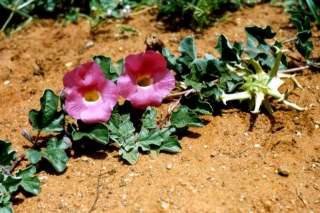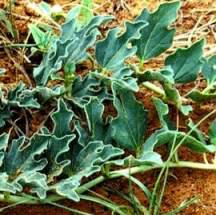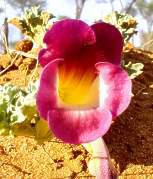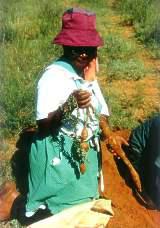Harpagophytum procumbens
Harpagophytum procumbens (Burch.) DC ex Meisn. subsp. procumbens and subsp. transvaalense Ihlenf. & H.E.K Hartmann
Family: Pedaliaceae
Common names: devil's claw, harpago, grapple plant, wool- and woodspider (Eng.); duivelsklou, bobbejaandubbeltjie, kloudoring, veldspinnakop (Afr.); teufelskralle, trampelklette (German); sengaparile, kanako, lekgagamare, ghamaghoe (Setswana); //x'aatataba, tloutaxaba (San), otjihangatene (Herero)
Introduction
Tread with care where Harpagophytum procumbens, or devil's claw, is lurking. It has nasty, spiny fruits but it is one of the chief medicinal plants southern Africa has given to the world. Its uses are multifarious and many tons of dried tubers are exported each year, mainly to Europe. Most of this is harvested in the wild so there has been much concern about over-harvesting. Efforts to get the plant into cultivation have not yet led to much success.

Description
Description
Devil's claw is a prostrate, sprawling plant with a stout, perennial rootstock that has a group of secondary storage tubers arising from it. Trailing annual stems bear opposite leaves. These are irregularly 3-5-lobed and greyish green because they are covered in tiny whitish mucilage cells.

The flowers are trumpet-shaped and range in colour from dark velvety red or purple to pink while the tube base and mouth are yellowish; they can be all yellow, all purple or white.

The very distinctive spiny fruits, from which many of the common names are derived, are woody, oval and flattened capsules armed with 2 central spines and 2 lateral rows of 12 - 16 horny arms bearing hooked spines. In subsp. procumbens the arms are longer than the fruit is wide, whereas in subsp. transvaalense they are as long as, or shorter than that.

The many seeds are roughly oblong and dark brown or black. The plants flower mainly from about November to April (summer) and have fruits from about January.
Conservation Status
Status
It is important to note that devil's claw is a protected plant in all three countries where it grows, (South Africa, Botswana and Namibia). This means that it is illegal to dig it up or harvest it, even one plant, without a permit from the various departments of nature conservation.
Distribution and habitat
Distribution description
Harpagophytum procumbens subsp. procumbens is found in most of Namibia, except the far northern, northeastern and western parts, Botswana and South Africa. In the latter it grows in the provinces of North-West, western Free State and Northern Cape. The subsp. transvaalense is found only in the far north of Limpopo Province. Devil's claw grows mostly in the savanna biome and is associated mainly with dry sandveld on deep Kalahari sand. It usually occupies plains, dune bases and interdunes. Soils are usually sandy but can be rocky. They are generally nutrient poor, often with lime. The plants can probably withstand some frost as they are geophytes, being dormant in winter. Distribution is often patchy.
Derivation of name and historical aspects
History
William Burchell gave this plant the name procumbens, meaning prostrate or lying down, in 1822. He placed it in the genus Uncaria and thought it was related to Martynia that also has a spiny fruit. In 1840, Meisner published De Candolle's name, Harpagophytum, for devil's claw. This name is a direct translation of 'grapple plant' into Greek. The genus occurs in southern Africa and Madagascar. In the former there are two species, H. procumbens and H. zeyheri Decne. Ihlenfeldt & Hartman (1970) established the two subspecies under H. procumbens, based mainly on the differing fruit and distribution.
Ecology
Ecology
Harpago's geophytic life form, with a perennial rootstock and annual stems, allows it to live in very arid places. The mucilage cells may help cut down water loss. The plants do not seem to like competition from other plants. Bees or crawling insects may be the pollinators, or perhaps hawk moths as they visit other similar flowers. The fruits are well adapted for dispersal by animals as the hooks get caught in feet and hair or skin and are carried away. Eventually they wear down, or drop off and break open, releasing the seeds far from the parent. Sometimes the animals die of starvation as the fruits catch on mouths and cannot be dislodged. Wind may also help in dispersal and trampling will help bury the seeds. The secondary tubers are dug up and eaten by porcupines and antelope such as duiker and steenbok.

Uses
Use
Devil's claw has long been known as a medicinal plant, with the San of the Kalahari having used it first, many generations ago. A German, G.H. Mehnert, learnt about this plant from the San and Nama people in Namibia and let it be known in 1904. It was exported to Germany first, and a small industry developed, based on material mainly from Namibia and Botswana. World demand has risen a lot since 1962 and especially in this century. Namibia has exported 2000 t. of dried roots in a year that may have involved up to 50 million plants.
The harvesters, of whom there are thousands, are almost all from very poor, rural communities living in near-desert conditions. They are mostly women, between 40 and 60 years old, who have little if any means of making a living and hence turn to harvesting devil's claw. This is despite the poor rewards for long hours and long distances travelled on foot.
Devil's claw is a veritable cure-all, but only whole extracts have the therapeutic effect, not isolated parts. The most important components are iridoid glycosides (mainly harpagoside, harpagide and procumbide). Some of its properties are listed: analgesic, anti-arrhythmic, antibacterial, anti-inflammatory, antirheumatic, diuretic, hypotensive, laxative, purgative, sedative, uterocontractant and a febrifuge, cholelogue and bitter tonic. In western medicine it is mainly used for arthritis and rheumatism. It apparently works like cortisone but without the bad side effects of that drug. In its local areas, and increasingly elsewhere, it has also been used for fever, blood diseases, blood purification, lower back pain and pain in pregnant women, coughs, diarrhoea, diabetes, bleeding gums, syphilis, gonorrhoea, gout and lumbago. It also helps with diseases of the liver, gall bladder, kidneys, pancreas, digestive system (heartburn, peptic ulcers, constipation and lack of appetite) and small joints, as well as hypertension, high cholestrol and tuberculosis. Externally it helps heal ulcers, boils, skin lesions and wounds (Neuwinger 2000; Powell 2001).
There are some contradictions and warnings in the literature ( such as in Duke et al . 2002). Devil's claw can be allergenic and is contra-indicated for diabetics and people with duodenal and gastric ulcers. Very high doses may act against blood pressure and cardiac therapy. Von Koenen (2001) reports that many local people consider that Europeans use this herb too strongly and damage may result. He noted that if the tea is drunk too strong and too often, cancer, kidney damage or arthritis might be caused. High doses may also cause abortion.

Growing Harpagophytum procumbens
Grow
Little is known about cultivating devil's claw and, as yet, it is not used in gardens. This is a pity and it should be tried for its beauty, let alone its medicinal properties. One method used for a farming trial (Strohbach 2004) could be adapted for a garden. Sow seed in a trench during mid- to late summer. Make the trench 0.2 m deep and up to 0.6 m wide in sand and line it with some mesh such as fly-gauze to prevent the tubers growing too deep. Mix some vermiculite or other water-retaining substance in the bottom 0.15 m of soil to help hold moisture. Sow the seeds onto this at a rate of about 100 g per 1 m row. Then cover the seed with 50 mm of sand and water daily. Take the small tubers out of the trenches just before winter and store them. Then plant them out in October and November (early summer), 0.1 m deep and 0.5 m apart. First prepare the ground by clearing away all other vegetation in a strip 3 m wide, alternating with the same width of uncleared ground, that will act as a windbreak. Little fertilizer and water are needed. In fact, over watering may lead to fungus problems. The only pests to worry about are animals eating the tubers. Flowers should appear in about the second summer after planting out. Wait 4 years for the first harvest when each plant should yield about 2 kg of fresh or ± 0.3 kg dry tuber.
References
- Anonymous. 2005. IUCN Congress highlights medicinal plants. Plant Talk 39: 7.
- Duke, J.A., Bogenschutz-Godwin, M.J., duCellier, J. & Duke, P.-A.K. 2002. Handbook of medicinal herbs , edn 2: 248, 249. CRC Press, London.
- Gittens, C. 2002. This is no mean crop. Farmer's Weekly 1 November 2002 : 40, 41.
- Golding, J.S. (ed.). 2002. Southern African Plant Red Data Lists. Southern African Botanical Diversity Network Report No. 14. SABONET, Pretoria.
- Hachfeld, B. 2003. Ecology and utilization of Harpagophytum procumbens (devil's claw) in southern Africa . Plant Species Conservation Monographs 2. Federal Agency for Nature Conservation, Bonn.
- Hachfeld, B. 2004. Long-term population changes of Harpagophytum procumbens (Burch.) DC. ex Meissn. (devil's claw) in Namibia . Schumannia 4, Biodiversity & Ecology 2: 217-224.
- Hauman, L. 2003. The benign devil. Farmer's Weekly 21 November 2003 : 30, 31.
- Ihlenfeldt, H-D. & Hartmann, H. 1970. Die gattung Harpagophytum (Burch.) DC. ex Meissn. (Monographie der afrikanischen Pedaliaceae II). Mitteilungen aus dem Institut für Allgemeine Botanik Hamburg 13: 15-69.
- Loots, S. 2005. Red Data book of Namibian plants. Southern African Botanical Diversity Network Report No. 38. SABONET, Pretoria.
- McVeigh, S. 2000. Good medicine for bad soil. Farmer's Weekly 11 August 2000 : 19, 20.
- Neuwinger, H.D. 2000. African traditional medicine, a dictionary of plant use and applications. Medpharm Scientific Publishers, Stuttgart.
- Powell, E. 2001. Devil's claw, protective measures to ensure the sustainable use of Harpagophytum procumbens, one of South Africa 's most valuable medicinal plants. Veld & Flora 87, 4 : 157.
- Raimondo, D., Newton . D., Fell. C., Donaldson, J. & Dickson, B. 2005. Devil's claw, Harpagophytum spp. in South Africa. Traffic Bulletin 20,3: 98-112.
- Strohbach, M. 2004. Devil's claw cultivation finally becoming a reality? Newsletter of the Namibian Scientific Society No. 45,1-3: 26-29.
- Van Wyk, B-E. & Gericke, N. 2000. People's plants: a guide to useful plants of southern Africa. Briza Publications, Pretoria.
- Van Wyk, B-E. & Wink, M. 2004. Medicinal plants of the world. Briza Publications, Pretoria.
- Victor et. al. in prep. The Red Data List of South African plants. Strelitzia.
- Von Koenen, E. 2001. Medicinal, poisonous and edible plants in Namibia : 126. Klaus Hess, Windhoek.
- Watt, J.M. & Breyer-Brandwijk, M.G. 1962. The medicinal and poisonous plants of southern and eastern Africa , edn 2: 830, 831. Livingstone, Edinburgh & London.
Credits
Shirley Smithies
National Herbarium, Pretoria
April 2006
Plant Attributes:
Plant Type: Perennial
SA Distribution: Free State, North West, Northern Cape
Soil type: Sandy
Flowering season: Early Summer, Late Summer
PH: Alkaline, Neutral
Flower colour: Pink
Aspect: Full Sun
Gardening skill: Challenging
Special Features:
Horticultural zones








Rate this article
Article well written and informative
Rate this plant
Is this an interesting plant?
Login to add your Comment
Back to topNot registered yet? Click here to register.